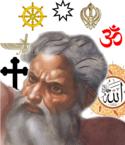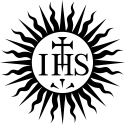Erich Przywara
| Erich Przywara | ||

|
||
| Biographie | ||
|---|---|---|
| Naissance |
Katowice |
|
| Ordre religieux | Compagnie de Jésus | |
| Ordination sacerdotale | ||
| Décès |
Murnau am Staffelsee |
|
| Autres fonctions | ||
| Fonction religieuse | ||
| Théologien | ||
|
|
||
|
(c) I, SajoR, CC BY-SA 2.5
|
||
| modifier |
||
Erich Przywara, né le à Kattowitz et mort le à Hagen, était un philosophe et théologien allemand de la compagnie de Jésus.
Biographie
Il enseigne de 1913 à 1917 dans l'établissement d'enseignement jésuite Stella Matutina à Feldkirch (Vorarlberg), et est ordonné prêtre en 1920. Przywara est influencé par saint Augustin, saint Thomas d'Aquin, le cardinal Newman, et la phénomologie d'Husserl et de Scheler. Il participe en 1928 et en 1929 aux cours universitaires de Davos, avec de nombreux autres intellectuels français et allemands. Son ouvrage le plus important s'intitule Analogia entis [1]; il y étudie l'analogie entre Dieu et la Création.
Doctrine
Erich Przywara entre en dialogue avec Karl Barth, Martin Buber, Edmund Husserl, Édith Stein, Gertrud von Le Fort, Jean Cavaillès. Il inspire Karl Rahner et Hans Urs von Balthasar. Pour le théologien, l'Analogia entis, devient la forme fondamentale du catholicisme. Elle fournit une réponse globale à la pensée moderne de la subjectivité et à la théologie transcendantale.
La méthode de Przywara consiste à dégager des plus grands auteurs une signification objective afin de les comprendre mieux qu'ils ne se sont compris eux-mêmes selon le principe herméneutique. Augustin, les mystiques rhénans, les romantiques allemands, Nietzsche, forment ainsi des nœuds qui s'opposent et se répondent dans l'histoire de la pensée selon un rythme interne et des polarités réciproques. Intégrant la logique pure, dialectisant l'analogie en une série d'opposition qui attendent leur dépassement, Przywara lui donne pour contenu la pensée occidentale dans toutes ses polarités. Leur unité dépasse ces oppositions, elle se dit en terme d'analogia entis, transformant un concept néo-scolastique en harmonie des contraires et en structure fondamentale de la vérité universelle (catholique). Ainsi l'histoire de la pensée échappe à l'historicisme sans être prise dans la logique hégélienne d'une progression irréversible[2].
Il faut noter la controverse célèbre qui l'opposa au théologien protestant Karl Barth. Alors qu'Erich Przywara cherche une coordination, fondée ontologiquement dans la tradition aristotélico-thomiste, entre la philosophie et la théologie, Barth interdit absolument à la philosophie l'accès à la théologie, allant jusqu'à traiter selon Rudolf Bultmann, l'Analogia entis , qui est aussi le titre d'un ouvrage de Przywara « d'invention de l'Antéchrist »[N 1].
Influence
« Przywara a profondément marqué la pensée théologique allemande de l'avant et de l'après-guerre, une pensée dont on sait le poids sur les travaux conciliaires. Des théologiens aussi différents que Karl Rahner et Hans Urs von Balthasar se reconnaissent une dette envers lui[.] Le rayonnement de Przywara s'étend aussi au-delà des frontières confessionnelles. De son vivant, il fut un interlocuteur attentif du protestantisme calviniste et luthérien »[3].
Références
- Przywara 1990
- article Analogie Dictionnaire critique de théologie, p. 42
- BIJU-DUVAL 2015, p. 241lire en ligne
Notes
- « Je tiens l'analogia entis pour une invention de l'Antéchrist, et j'estime que c'est à cause de cela que l'on ne peut pas devenir catholique ». Il range ainsi l'analogia entis et la théologie naturelle fondée sur elle dans la ligne de la théologie issue de l' « Aufklärung » et du libéralisme contre lequel il n'a cessé de lutter-Rudolf Bultmann,Paul Corset,Pierre Gisel 1987, p. 186lire en ligne
Publications
- En français
- Augustin : Passions et destins de l'Occident, trad. Philibert Secretan, éd. Cerf, 1987 (site du Cerf)
- Analogia Entis, éd. PUF, 1990
- Leçons sur Dieu, trad. Philibert Secretan, col. Philosophie et Théologie, éd. Cerf, 2011 (site du Cerf)
- Majestas divina : spiritualité ignatienne, éd. Ad Solem, 2014
- Autres langues
- Religionsphilosophie katholischer Theologie, Munich, R. Oldenbourg, 1927
- Analogia Entis, 1932
- Mensch : typologische Anthropologie, Nuremberg, Glock und Lutz, 1959
Bibliographie
- Jean-Yves Lacoste+collectif (dir.), Dictionnaire critique de théologie, Paris, PUF, coll. « Quadrige », , 1314 p. (ISBN 2-13-052904-6).
- Erich Przywara (trad. de l'allemand par Philippe Secretan), Analogia entis, Paris, PUF, coll. « Théologiques », , 190 p. (ISBN 2-13-042906-8).
- Eva-Maria Faber: Einführung zu Erich Przywara. In: Josef Weismayer, Gisbert Greshake (Hrsg.): Quellen geistlichen Lebens. Band 4: Die Gegenwart. Grünewald, Mainz 1993, S. 101f.
- Eva-Maria Faber: Przywara, Erich. In: Theologische Realenzyklopädie. 27, 1997, S. 607–610.
- Peter Lüning: Der Mensch im Angesicht des Gekreuzigten. Untersuchungen zum Kreuzesverständnis von Erich Przywara, Karl Rahner, Jon Sobrino und Hans Urs von Balthasar. (Münsterische Beiträge zur Theologie 65). Münster 2007.
- Stephan Lüttich: Nacht als Locus theologicus. Theologie der Nacht und Nacht der Theologie bei Erich Przywara. In: Stephan Lüttich: Nacht-Erfahrung. Theologische Dimensionen einer Metapher. Würzburg 2004, S. 242–299. (StSSTh 42)
- Thomas Schumacher: In-Über: Analogie als Grundbestimmung von Theo-Logie; Reflexionen im Ausgang von Erich Przywara. München 2003, (ISBN 3-936909-00-8).
- Karl-Heinz Wiesemann: Zerspringender Akkord: das Zusammenspiel von Theologie und Mystik bei Karl Adam, Romano Guardini und Erich Przywara als theologische Fuge. Würzburg 1999.
- Martha Zechmeister : Erich Przywaras Weg negativer Theologie. Lit, Münster 1997, (ISBN 3-8258-3105-1).
- Martha Zechmeister: Erich Przywara. In: Lexikon für Theologie und Kirche. Band 8, Sp. 688–689.
Annexes
Articles connexes
- Liste d'auteurs jésuites contemporains
- Analogia entis
- Analogie (métaphysique)
Liens externes
- Denis BIJU-DUVAL, « La pensée d'Erich Przywara », Nouvelle Revue Théologique 121(1999), p. 240-253.
- Rudolf Bultmann, Paul Corset et Pierre Gisel, « Karl Barth : genèse et réception de sa théologie », Labor et Fides, (ISBN 2-8309-0091-X), p. 276.
Médias utilisés sur cette page
A medieval-style version of the IHS (or JHS) monogram of the name of Jesus (i.e. the traditional Christogram symbol of western Christianity), derived from the first three letters of the Greek name of Jesus, Iota-Eta-Sigma (ΙΗΣΟΥΣ).
For a more modern version, see JHS-IHS-Monogram-Name-Jesus.svg.
For a medieval-style IHC (JHC) monogram (alternative lunate-sigma version), see IHC-monogram-Jesus-medievalesque.svg.
SVG version of IHS-monogram-Jesus-medievalesque.png.The last ever flight of any Concorde, 26th November 2003. The aircraft (G-BOAF) is overflying Filton airfield at two thousand feet to take a wide circle over the Bristol area before the final landing on the Filton (Bristol) runway from which she first flew in 1979, and from which the first British Concorde flew in 1969.
Auteur/Créateur: Blok Glo, Licence: CC BY-SA 3.0
Image of the painting Creation of the Sun and Moon by Michelangelo (c. 1512) surrounded with the symbols of religions. Composition of images w:File:Creation of the Sun and Moon face detail.jpg, w:File:Orthodox cross.svg, w:File:Dharma Wheel.svg, w:File:Faravahar-Gold.svg, w:File:SikhiKhanda.png, w:File:Aum.svg, w:File:Allah-eser2.png.
Monochrome version of the IHS emblem of the Jesuits.
The design of the emblem is attributed to Ignatius of Loyola (1541).
- the cross is here drawn as formy fitchy; this is not necessarily part of the design, early modern depictions sometimes show a plain cross, or various baroque ornamentations
- the three nails are sometimes shown as piercing a heart
- the alternating straight and wavy rays are found in historical specimens, but not necessarily, and sometimes with two or three straight rays separating wavy rays.
- the number of rays is often 32 as here, but sometimes also 12, 16 or 24.
- the emblem is sometimes surrounded by the inscription et vocatum est nomen eius Iesus (Luke 2:21)
Erich Przywara in den 1920er Jahren







